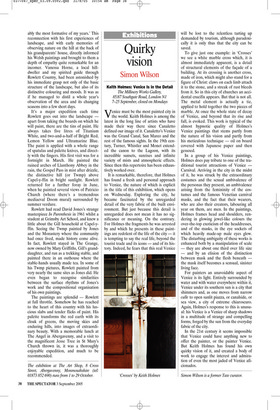Quirky vision
Simon Wilson
Keith Holmes: Venice Is in the Detail
The Millinery Works Gallery, 85/87 Southgate Road, London N1 7–25 September, closed on Mondays
Venice must be the most painted city in the world. Keith Holmes is among the latest in the long line of artists who have made their way there since Canaletto defined our image of it. Canaletto’s Venice was the Grand Canal, San Marco and the rest of the famous sights. In the 19th century, Turner, Whistler and Monet extended the canon to the Lagoon, with its incredible sunsets, sunrises and infinite variety of mists and atmospheric effects. Since then this repertoire has been exhaustively worked over.
It is remarkable, therefore, that Holmes has found a fresh and personal approach to Venice, the nature of which is explicit in the title of this exhibition, which opens on Wednesday. Exploring the city, he became fascinated by the unregarded detail of the very fabric of the built environment. But just because this detail is unregarded does not mean it has no significance or meaning. On the contrary. For Holmes the fragments he was arrested by and which he presents in these paintings are redolent of the life of the city — it is tempting to say the real life, beyond the tourist trade and its icons — and of its history. Indeed, he fears that this real Venice will be lost to the relentless tarting up demanded by tourism, although paradoxically it is only thus that the city can be saved.
To give just one example: in ‘Crosses’ we see a white marble cross which, it is almost immediately apparent, is a detail of structural elements of the façade of a building. At its crossing is another cross, made of iron, which might also stand for a figure of Christ: claws on each limb attach it to the stone, and a streak of rust bleeds from it. So in this city of churches an accidental crucifix appears. But that is not all. The metal element is actually a tie, applied to hold together the two pieces of marble. At once the whole state of decay of Venice, and beyond that its rise and fall, is evoked. This work is typical of the almost hypnotic quality of Holmes’s Venice paintings that stems partly from the nature of his vision and partly from his meticulous technique — oil on board covered with Japanese paper and then gessoed.
In a group of his Venice paintings, Holmes does pay tribute to one of the traditional tourist attractions of Venice Carnival. Arriving in the city in the midst of it, he was struck by the extraordinary costumes and the sexual ambivalence of the personas they present, an ambivalence arising from the femininity of the costumes and the famous Venetian carnival masks, and the fact that their wearers, who are also their creators, labouring all year on them, are men. In the paintings, Holmes frames head and shoulders, rendering in glowing jewel-like colours the over-the-top exoticism of the headdresses, and of the masks, in the eye sockets of which heavily made-up male eyes glow. The disturbing ambiguity of these works is enhanced both by a manipulation of scale — they are about one third over life size — and by an elision of the distinction between mask and the flesh beneath the mask itself becomes a sensual, sinister living face.
For painters an unavoidable aspect of Venice is its light. Entirely surrounded by water and with water everywhere within it, Venice under its southern sun is a city that shimmers and, as one moves from narrow calle to open sunlit piazza, or canalside, or sea view, a city of extreme chiaroscuro. Again, Holmes’s response to this is unusual: his Venice is a Venice of sharp shadows in a multitude of strange and compelling forms, forged by the sun from the everyday fabric of the city.
In the 21st century it seems impossible that Venice could have anything new to offer the painter, or the painter Venice. But Keith Holmes has found his own quirky vision of it, and created a body of work to engage the interest and admiration of even the most jaded of Venice aficionados.









































 Previous page
Previous page